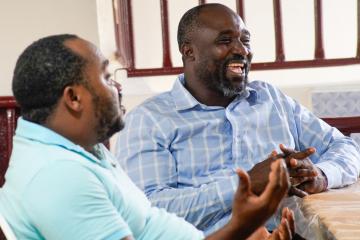What does a rewarding life look like to you? How about this … imagine you’ve found a teacher to look up to, who offers you ongoing support and inspiration. A philosophy that helps guide you through the ups and downs of life. A community which you feel inspired by and at home within. Sounds good, right? A life on purpose, supported by someone motivating and surrounded by like-minded people.
This is something that many people find themselves searching for and is one way to interpret the “three jewels” of Buddhism. The philosophy is ancient in its origin and relevant in today’s world.
So often we can find ourselves feeling a bit rudderless — a little lost and without much drive. Especially after the past few years, many of us feel that there is something missing from our lives. A dear friend said to me the other day, “I just feel so flat. I know intuitively there must be more to life than this!? And yet, I am unsure of where to find it, how to grasp it.” I know it’s a sentiment that is relevant for so many.
As organised religion isn’t as prevalent for many of us as it once was and the philosophy of consumerism falls further to its knees, losing even more of a hold on us, we can find ourselves wondering, “What else can I do with this wild and precious life of mine?”
After the years that we have been through, both environmentally with bushfires and floods on top of years of the pandemic, it’s easy to feel deflated. It’s in these times that frameworks such as the three jewels can be lifesaving. Even if it’s not strictly followed, as guidelines, they are worthwhile and can help us live more aligned with our unique desires and intentions.
What are the three jewels?
These three treasures are buddha, dharma and sangha. They stem from teachings by Siddhartha Gautama or Gautama Buddha and are offered as a pathway from suffering to freedom. The “triple gems”, as they are also known, are the foundation for (if followed properly) becoming a bodhisattva (someone devoted to the path of awakening) or a Buddhist monk. That aside, even for those of us not wanting to commit to a monastic life, they can, in a more generic way, form a direction for us to find more peace and less suffering on a daily level. They give us a framework — guard rails, so to speak — so that we can stay true to our highest selves and authentic nature.
Let’s have a look at each jewel in more detail.
Buddha (the exemplar)
This jewel refers to the Buddha himself, who lived during the latter half of the first millennium BCE. He was the founder of Buddhism and is revered by Buddhists as an enlightened being and an extraordinary teacher. So, this jewel both acknowledges him as a teacher but also acknowledges his teachings themselves as inspiration. For me, this translates to finding a yoga or meditation teacher, a mentor or even a therapist who is further along the path than us and who can guide us back to our centre. Basically, someone in our life to whom we give our trust and aspire to be more like or, really, to remind us of all that already exists within us. These people help us find our way back to ourselves. Like all great teachers, their goal is to help us find our way back to the wisdom that is already within us.
Dharma (the teachings)
This jewel suggests we use the teachings as a way to live life more aligned — much the same way we could use the Indian yogic system of the yamas and niyamas outlined by Patanjali as part of his eight limbs. Having these moral guidelines as a compass and a roadmap for life can help us make sense of modern living, in the framework of ancient wisdom and teachings, and we can use life (rather than withdraw from life) as an extension of our practice; actually, as a way to put our practice to practise!
This jewel is about having moral and ethical direction to live by and not deviating from these when things get tough. For example, within the Dhammapada, written by Siddhartha Gautama, he invites “learning to do good; ceasing to do evil; purifying the heart”.
So, we learn and then (as best as we can) live by the teachings and have them as our compass for finding and re-finding our true north. In doing this, we more often feel at peace knowing that we are living authentically, with our actions matching our beliefs and with less and less discrepancies. As above, so below, as they say.
Sangha (the community)
This last jewel is one of my favourites and more relevant today than ever before. Since the beginning of time, humans have sought to find communities to belong to. Historically for safety and protection, yes, but more recently for inspiration and connection. Whether it’s making friends at your yoga school, staying in touch with people you meet on a meditation retreat, yoga training or a local group in your community, having these people in our lives can be extremely comforting and inspiring.
A true community is not just about being geographically close to someone or part of the same social network. It’s about feeling connected and responsible for what happens within the community. Humanity is our ultimate community, and everyone plays a crucial role.
At the end of my practice in the morning, I honour these three treasures symbolically and bring my hands in anjali mudra to my forehead as I thank my teachers (buddha) and all those who have influenced my practice and who have come before me. Then, I bring my hands to my heart and give thanks to the teachings of Buddhism (dharma) and yoga that help me so much in my daily life and ask that I share it wisely and widely. Lastly, I bow to my community (sangha) — everyone I have sat with in trainings, silent meditation retreats, classes and my beloved communities at Egg of the Universe and fellow practitioners everywhere! Sometimes I will picture these people with me in ever-widening concentric circles and it gives me the most profound sense of feeling grounded, connected, uplifted and supported by other humans on a similar path. As Brian Solis says, “Community is about doing something together that makes belonging matter.”
Putting the three jewels into practice
Find something that uplifts you, be it meditation classes, breathwork sessions, a women’s or men’s circle, a local or online yoga studio. Find a teacher or mentor who helps you come back home to you. They don’t have to be enlightened, just further ahead on the path than you to help light the way. Then, put what you learn into practice and begin to take steps to live the teachings. It can start out as small actions and build up over time so that how you’re living is an extension of what you’re learning on your yoga mat or meditation cushion. We are never alone if we take refuge in the three jewels. It is something we can take solace in and strength from in the challenges of life.
By following these simple steps, we can find great joy and lasting freedom in our modern life, regardless of our circumstances. We can start now, using our life exactly as it is as a doorway into a life that becomes enriching and enlightening, regardless of how it looks from the outside. Living in this way, we can feel less struggle and more freedom, which is, of course, a central motivation for many wisdom practices.
Photography Tessa Tran, Breathing Light Photography
Note: This article have been indexed to our site. We do not claim legitimacy, ownership or copyright of any of the content above. To see the article at original source Click Here













